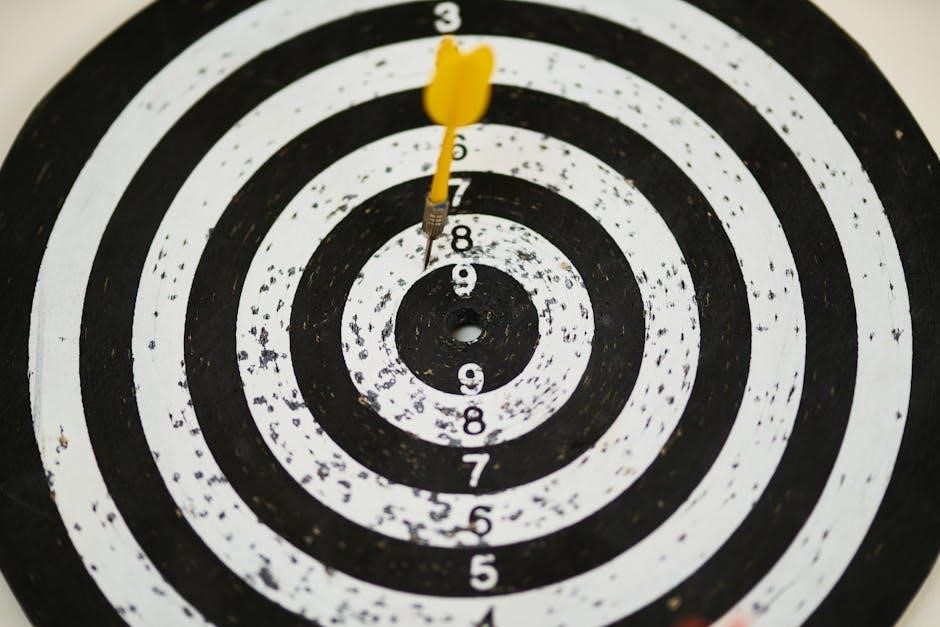Article Plan: Circumference of Circle Worksheet PDF
This article offers a structured approach to understanding the circumference of circles. It provides a guide to utilizing worksheet PDFs. These worksheets reinforce concepts with practice problems and real-world applications. It includes answer keys for self-assessment and skill improvement.
Circles‚ fundamental geometric shapes‚ play a crucial role in mathematics and our understanding of the world. The circumference‚ a key property of circles‚ represents the distance around the circle. Exploring the concept of circumference provides insights into various mathematical principles and practical applications.
Circumference worksheets are valuable tools for learning and reinforcing this concept. These worksheets offer a structured approach to understanding circumference through practice problems and visual aids. They cater to different skill levels‚ allowing learners to gradually grasp the concept and develop problem-solving abilities. Worksheets often include real-world examples to demonstrate the relevance of circumference in everyday situations.
These educational resources help students master the formula for calculating circumference. The formula involves using either the radius or the diameter of the circle. Radius-based worksheets focus on applying the formula C = 2πr. Diameter-based worksheets emphasize the formula C = πd. By working through these worksheets‚ students gain confidence. Confidence gained in applying these formulas enhances their mathematical proficiency.
Circumference worksheets are widely available online‚ offering accessibility and convenience for students and educators. These worksheets often come with answer keys‚ enabling self-assessment and immediate feedback. Utilizing circumference worksheets can significantly enhance learning. Learning can improve and make the study of circles more engaging and effective.
Understanding Circumference: Definition and Formula (C = 2πr or C = πd)
The circumference of a circle is defined as the distance around the circle. It is a fundamental property that helps us understand the size and scale of circular objects. Knowing how to calculate the circumference is essential in various fields‚ from geometry and engineering to everyday problem-solving.
The circumference (C) can be calculated using two primary formulas. The first formula‚ C = 2πr‚ relates the circumference to the circle’s radius (r). The radius is the distance from the center of the circle to any point on its edge. The second formula‚ C = πd‚ relates the circumference to the circle’s diameter (d). The diameter is the distance across the circle passing through its center.
Both formulas involve the mathematical constant pi (π)‚ which is approximately equal to 3.14159. Pi represents the ratio of a circle’s circumference to its diameter. It is a constant value that remains the same regardless of the size of the circle.
To calculate the circumference‚ you need to know either the radius or the diameter of the circle. If you know the radius‚ you can use the formula C = 2πr. If you know the diameter‚ you can use the formula C = πd. Both formulas will give you the same result‚ as the diameter is twice the radius (d = 2r).
Understanding these formulas and their relationship to the circle’s properties is crucial for solving circumference-related problems.
Components of a Circle: Radius‚ Diameter‚ and Pi (π)
To fully grasp the concept of a circle’s circumference‚ it’s essential to understand its fundamental components: the radius‚ the diameter‚ and the mathematical constant Pi (π). Each plays a crucial role in defining and calculating a circle’s properties.
The radius of a circle is the distance from the center of the circle to any point on its edge. It’s a straight line segment that extends from the center to the perimeter. Understanding the radius is essential because it’s a direct measure of the circle’s size.
The diameter‚ on the other hand‚ is the distance across the circle passing through its center. It’s a straight line segment that connects two points on the circle’s edge and passes through the center. The diameter is twice the length of the radius. Knowing the diameter is equally important as it provides another way to determine the circle’s size.
Pi (π) is a mathematical constant that represents the ratio of a circle’s circumference to its diameter. It’s an irrational number‚ meaning its decimal representation goes on infinitely without repeating. Pi is approximately equal to 3.14159‚ but for most practical calculations‚ 3.14 is sufficient.
These three components are interconnected. The radius and diameter define the size of the circle‚ while Pi provides the constant relationship between the diameter and the circumference. Understanding these components is the foundation for calculating the circumference.
Types of Circumference Worksheets: Radius-Based‚ Diameter-Based
Circumference worksheets come in two primary types‚ each designed to cater to different problem-solving approaches: radius-based and diameter-based worksheets. These types offer varied practice opportunities for mastering circumference calculations.
Radius-based worksheets provide the radius of a circle and require students to calculate the circumference using the formula C = 2πr. These worksheets emphasize understanding the relationship between the radius and circumference. They help students practice multiplying the radius by 2π to find the total distance around the circle.
Diameter-based worksheets‚ conversely‚ provide the diameter of a circle and require students to calculate the circumference using the formula C = πd. These worksheets focus on the direct relationship between the diameter and circumference. Students learn to multiply the diameter by π to find the total distance around the circle.
Both types of worksheets are valuable for developing a comprehensive understanding of circumference. Radius-based worksheets reinforce the concept of the radius as the foundational measurement‚ while diameter-based worksheets streamline the calculation process. By working with both types‚ students gain flexibility in approaching circumference problems.
Additionally‚ some worksheets may combine both radius and diameter problems‚ offering a mixed practice experience. This mixed approach challenges students to identify the given measurement and apply the correct formula‚ further enhancing their problem-solving skills.
Calculating Circumference Using Radius: Examples and Practice Problems
Calculating the circumference of a circle using the radius involves applying the formula C = 2πr. This formula highlights the direct relationship between a circle’s radius and its circumference. Understanding this relationship is crucial for solving circumference problems.
For example‚ if a circle has a radius of 5 cm‚ the circumference would be calculated as follows: C = 2 * π * 5 cm = 10π cm. Using π ≈ 3.14‚ the circumference is approximately 31.4 cm.
Practice problems often present varying radius values‚ challenging students to apply the formula consistently. These problems may include circles with radii ranging from small values like 1 cm to larger values like 25 cm‚ requiring careful calculation and attention to detail.
Worksheets typically provide a series of such problems‚ allowing students to reinforce their understanding and improve their calculation skills. Each problem offers an opportunity to practice substituting the radius value into the formula and arriving at the correct circumference.

Furthermore‚ some practice problems may require students to round their answers to a specific number of decimal places or significant figures‚ adding an extra layer of complexity. This reinforces the importance of precision and attention to detail in mathematical calculations.
By working through a variety of examples and practice problems‚ students can develop a solid understanding of how to calculate the circumference of a circle using its radius.
Calculating Circumference Using Diameter: Examples and Practice Problems
Calculating the circumference using the diameter is straightforward with the formula C = πd. This formula directly relates the circle’s diameter to its circumference‚ offering an efficient method for calculation.

For instance‚ consider a circle with a diameter of 8 cm. Using the formula‚ the circumference is C = π * 8 cm = 8π cm. Approximating π as 3.14‚ the circumference is approximately 25.12 cm.

Practice problems frequently involve circles with varying diameters. These exercises reinforce the application of the formula and enhance calculation proficiency. The diameters might range from small values to larger ones‚ requiring students to adapt their calculations accordingly.
Worksheets typically feature numerous such problems‚ allowing students to practice and solidify their understanding. Each problem provides an opportunity to substitute the diameter value into the formula and determine the correct circumference.
Some problems may also require rounding answers to a specified number of decimal places or significant figures. This adds an element of precision to the calculations‚ emphasizing the importance of accuracy.
Through consistent practice with diverse examples‚ students can master the calculation of a circle’s circumference using its diameter. This skill is fundamental in geometry and has practical applications in various real-world scenarios.
By working through the practice problems‚ students gain confidence in applying the formula and arriving at accurate solutions.
Rounding Circumference Answers: Significant Figures and Decimal Places
When calculating circumference‚ π is often approximated as 3.14‚ or a more precise value from a calculator. This approximation necessitates rounding the final answer. Rounding ensures the answer is presented with appropriate precision‚ reflecting the accuracy of the input values and calculations.
Significant figures indicate the number of meaningful digits in a number. When rounding to a certain number of significant figures‚ we retain only the most important digits. For example‚ rounding 25.1327 to three significant figures gives 25.1.
Decimal places‚ on the other hand‚ refer to the number of digits after the decimal point. Rounding 25.1327 to two decimal places results in 25.13. The context of the problem often dictates whether to round to significant figures or decimal places.
In practical applications‚ understanding the required level of precision is crucial. Overly precise answers might imply a level of accuracy that doesn’t exist‚ while insufficient precision can lead to unacceptable errors.
Circumference worksheets often include instructions on how to round answers. Students must follow these instructions carefully to provide accurate and appropriately rounded solutions. This skill is essential for accurate calculations and clear communication of results.
Rounding practice reinforces mathematical precision and helps in estimating reasonable results. By working through various problems‚ students gain confidence in rounding and interpreting their results effectively. This ensures that their answers are not only correct but also appropriately presented for the given context.
Applications of Circumference: Real-World Examples and Problems
Circumference isn’t just a theoretical concept; it has numerous practical applications in everyday life. Understanding circumference helps us solve real-world problems related to circular objects.
One common application is calculating the distance traveled by a wheel in one rotation. Knowing the wheel’s circumference allows us to determine how far a bicycle or car moves with each turn of the wheels. This is crucial in understanding speed and distance measurements.
In engineering‚ circumference is vital in designing circular structures like pipes‚ gears‚ and rotating machinery. Accurate circumference calculations ensure proper fit and functionality of these components. For example‚ calculating the circumference of a pipe helps determine the amount of material needed to cover it.
Circumference also plays a role in architecture. Architects use it to design circular buildings‚ domes‚ and decorative elements. Understanding the circumference helps in planning the layout and structural integrity of these designs.
In manufacturing‚ circumference is used in creating circular products like rings‚ bracelets‚ and circular containers. Precise measurements are essential for ensuring the correct size and shape of these items.
Circumference problems often involve finding the length of a circular track‚ the amount of fencing needed for a circular garden‚ or the distance around a circular pond. These problems highlight the practical relevance of understanding circumference in everyday scenarios.
By exploring real-world examples‚ students can appreciate the significance of circumference and its impact on various fields‚ enhancing their problem-solving abilities and mathematical intuition.
Creating Your Own Circumference Worksheet: Tips and Resources
Designing your own circumference worksheet can be a rewarding way to reinforce learning and tailor exercises to specific skill levels. Start by defining the learning objectives. Decide whether the focus will be on radius-based problems‚ diameter-based problems‚ or a mix of both.
Begin with simpler problems to build confidence. Gradually increase the difficulty by introducing larger numbers‚ decimals‚ and fractions. Include a variety of question formats‚ such as calculating circumference given the radius or diameter‚ finding the radius given the circumference‚ and solving word problems.
Incorporate real-world scenarios to make the worksheet more engaging. For instance‚ ask students to calculate the circumference of a bicycle wheel or a circular garden. Use clear and concise language to avoid confusion.
Include diagrams of circles with labeled radii or diameters to aid visual learners. Provide ample space for students to show their work. Consider adding a section for students to explain their problem-solving strategies.
Utilize online resources and math worksheet generators to create professional-looking worksheets. Websites like Math-Drills and Kuta Software offer tools to customize and generate math problems. Ensure the worksheet is visually appealing and easy to read.
Always include an answer key for self-assessment. Review the worksheet for accuracy and clarity before distributing it to students. Encourage creativity and critical thinking by including challenging problems that require students to apply their knowledge in unique ways.
Answer Keys and Solutions: Checking Your Work
Answer keys are essential companions to circumference worksheets‚ providing students with the means to verify their calculations and understanding. A well-prepared answer key offers more than just the final answers; it can also include step-by-step solutions‚ guiding students through the problem-solving process.

The answer key should be organized and easy to navigate‚ with clear labeling that corresponds to the worksheet questions. Include both the exact answers (in terms of π) and approximate answers (rounded to a specified number of decimal places or significant figures)‚ catering to different instructional needs.
For more complex problems‚ provide detailed solutions that demonstrate the application of the circumference formula (C = 2πr or C = πd) and the steps involved in isolating variables to solve for radius or diameter.
Encourage students to use the answer key not only to check their work but also to identify areas where they struggled. If a student consistently makes errors on a particular type of problem‚ it indicates a need for further review and practice.
Consider including common mistakes in the answer key along with explanations of why they are incorrect. This can help students avoid these pitfalls and develop a deeper understanding of the concepts.
Answer keys promote self-assessment and independent learning‚ empowering students to take ownership of their progress. They also provide valuable feedback to teachers‚ highlighting areas where students may need additional support.
